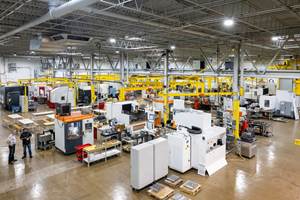Apprentice Training - Precision Inspection and Measurement
Here are some basic principles concerning inspection and measurement to take into account when developing your related technical instruction (RTI) plan.
Explaining to a new apprentice the ±0.00007 tolerances of a medical component that might end up as an implant in a person’s spinal cord, and why those tolerances are important, requires a significant amount of effort, as it did for me when I first entered the trade.
I recall being 16 years old in my machine tool class with Mr. Rodgers as he was explaining how to use a micrometer. Up until that point in my life, I only knew the accuracy of a tape measure. When Mr. Rodgers demonstrated micrometer accuracy by measuring a piece of paper, a new world opened up for me. I often remember this experience because I teach so many people who are new to the trade, and it revealed to me how the concepts of precision and accuracy are almost completely unknown. Here are some basic principles concerning inspection and measurement to take into account when developing your related technical instruction (RTI) plan.
Measurement. To understand precision, the apprentice must first understand the concept of measurement. This seems rudimentary at first, until you look at measurement as it relates to standards. The numbers used in measurement are not random. Every apprentice must understand that all measurement connects to a standard. For example, imperial or metric, and how these are used in different regions or industries. Even in ancient times, there were standards. The pyramids were built according to the measurement standard of the cubit, which was the length from a person’s elbow to his fingertips. Having a solid understanding of measurement and standards leads to a better long-term ability to understand quality and quality control. Part and process quality are all rooted in the ability to take accurate measurements. There are many good books, articles and online courses that can teach the theory of measurement and help the apprentice learn these concepts throughout his or her RTI.
Tolerance. Depending on how much time an apprentice has spent building material goods, the concept of tolerance may also be new. Many apprentices create a lot of scrap because they do not fully understand acceptable part variation. For example, oftentimes when using basic machining concepts to teach the value of tolerance, I have the apprentice build a simple set of 1-2-3 blocks. When the apprentice goes to the trouble of milling, drilling, heat treating and grinding the 1-2-3 block, and it ends up as a 0.998-1.999-2.9975 block, making it scrap, an important light bulb goes off. Suddenly, the apprentice understands how the concept of measurement is tied to the concept of tolerance. His or her inability to properly measure resulted in an out-of-tolerance part. When this happens, the term “quality” takes on a whole new meaning. A 1-2-3 block must be exactly 1 inch by 2 inches by 3 inches, nothing bigger or smaller. This will lead to a proper understanding of the various tolerances that exist, such as dimensional, fit, assembly, location, form and orientation.
Common measurement tools. Once the apprentice understands measurement and tolerance at a conceptual level, it is time to learn about the unique tools for taking measurements, such as micrometers, calipers, height gages and indicators. These are not tools typically found in the average person’s garage, so it may take time for the apprentice to reach a workable comfort level. In addition, there is still a lack of general knowledge about some of the lesser-used measurement tools, such as optical comparators, gage blocks, sine bars and sine plates. These must also be taught.
On top of that, explaining the proper role and care of surface plates is another important facet of measurement, which should also include an overview of the variety of gages, such as bore and thread gages. The best way to teach an apprentice about these tools is to let him or her use them on actual parts and to physically show their application. However, if this is not possible, online training resources are available.
Job layout. Measurement and inspection used to always include an in-depth exercise in how to perform an accurate job layout. Today’s CAD/CAM and CNC have virtually eliminated most of this work as it applies to mold building, but learning how to use precision measurement instruments for this operation still teaches important concepts about location, compounding tolerances and size. When an apprentice can use precision measurement instruments to lay out part details and features from a print, he has attained a high-level mastery of the skill.
These are sometimes considered old-fashioned skills, but it is easy to forget that, if we want apprentices to become experts in their trade with high levels of critical thinking, we must retain some of the old practices, at least in how we teach them.
Quality inspection. The goal of a good precision measurement and inspection course is to teach the apprentice how to properly use precise tools and techniques to determine the quality of a part or process. This is a massive undertaking, as many times the level to which an apprentice must perform quality inspection is directly related to the industry in which he or she is working.
For example, shops within the aerospace industry are often required to perform far more intense job and process inspection procedures than those within the automotive industry. I believe that no matter what the industry, apprentices should learn the highest level of skills and ones that are transferable, equipping them for the rest of their careers, no matter where it takes them.
As you build your shop’s related technical instruction plan, ensure that the class goes deep enough and shows the variety of applications that precision measurement and inspection can encompass. Although it is easy to only teach an apprentice how to use micrometers, calipers and indicators, you will add a tremendous amount of depth to your workforce by teaching more, and perhaps incorporating some skills of the past.
Related Content
Cross Training, In-House Capabilities and Collaborative Design Move Helm Tool Forward
Cross-training, bringing it all in-house, molding and collaborative design are essential to Helm Tool's success.
Read MoreMMT Chats: It’s Time to Play … The Moldmaker Card Game! Yes, a Game to Educate and Entertain
MoldMaking Technology Editorial Director Christina Fuges connects with Professor Steffen Ritter from Reutlingen University in Germany about the card game for moldmakers he developed to help promote and educate our next generation of moldmaking professionals in a fun way. This episode is brought to you by ISCAR with New Ideas for Machining Intelligently.
Read MoreMaking Mentoring Work | MMT Chat Part 2
Three of the TK Mold and Engineering team in Romeo, Michigan join me for Part 2 of this MMT Chat on mentorship by sharing how the AMBA’s Meet a Mentor Program works, lessons learned (and applied) and the way your shop can join this effort.
Read MoreMold Maintenance Continues to Matter: Enhanced Training Program in a New Facility
I attended a MoldTrax mold maintenance workshop in 2019 and shared my experiences, and despite changes in ownership, the workshop's remarkable value endures, as discussed in a recent Q&A with the current leadership.
Read MoreRead Next
How to Use Continuing Education to Remain Competitive in Moldmaking
Continued training helps moldmakers make tooling decisions and properly use the latest cutting tool to efficiently machine high-quality molds.
Read MoreReasons to Use Fiber Lasers for Mold Cleaning
Fiber lasers offer a simplicity, speed, control and portability, minimizing mold cleaning risks.
Read MoreHow to Use Strategic Planning Tools, Data to Manage the Human Side of Business
Q&A with Marion Wells, MMT EAB member and founder of Human Asset Management.
Read More





















